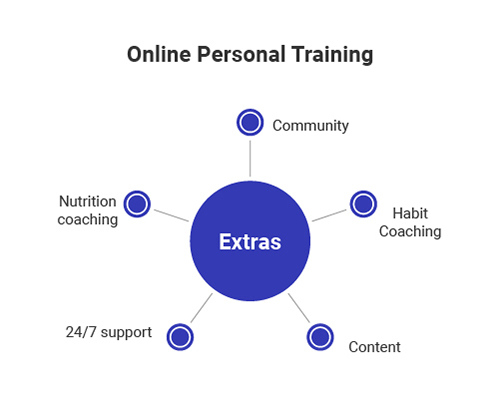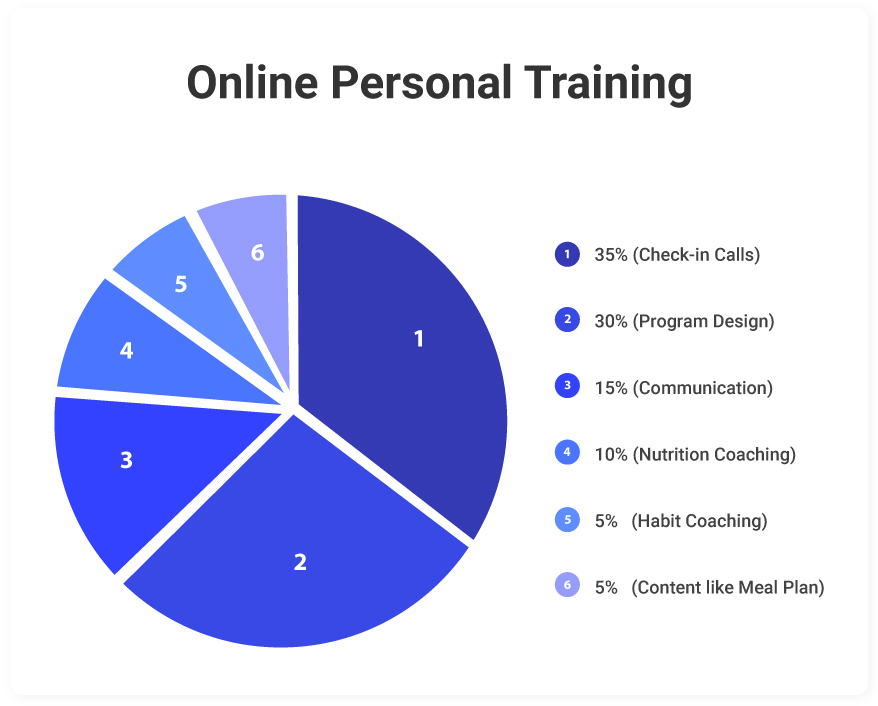The Rise of Online Personal Training: A Comprehensive Guide to a Dynamic Career Path
Related Articles: The Rise of Online Personal Training: A Comprehensive Guide to a Dynamic Career Path
Introduction
In this auspicious occasion, we are delighted to delve into the intriguing topic related to The Rise of Online Personal Training: A Comprehensive Guide to a Dynamic Career Path. Let’s weave interesting information and offer fresh perspectives to the readers.
Table of Content
The Rise of Online Personal Training: A Comprehensive Guide to a Dynamic Career Path

The fitness industry has undergone a significant transformation in recent years, with the emergence of online personal training as a prominent and increasingly popular career path. This shift has been driven by a confluence of factors, including the widespread adoption of technology, the growing demand for personalized fitness solutions, and the convenience and accessibility offered by virtual platforms.
This article provides a comprehensive overview of online personal training jobs, exploring their nature, benefits, challenges, and future prospects. It delves into the essential skills, qualifications, and strategies required to succeed in this dynamic field, offering a detailed roadmap for aspiring online personal trainers.
Defining Online Personal Training
Online personal training involves providing fitness guidance and support to clients remotely through various digital platforms. This encompasses a wide range of services, including:
- Personalized Training Programs: Crafting tailored workout plans based on individual goals, fitness levels, and preferences.
- Nutrition Counseling: Providing guidance on healthy eating habits, meal planning, and dietary adjustments.
- Exercise Technique Coaching: Demonstrating proper form and providing feedback through video calls, messaging, or video analysis tools.
- Motivation and Accountability: Offering encouragement, support, and regular check-ins to maintain client engagement and progress.
- Progress Tracking: Monitoring client progress through data analysis, fitness assessments, and regular communication.
Advantages of Online Personal Training
The rise of online personal training is driven by its numerous advantages, both for trainers and clients.
For Clients:
- Accessibility and Convenience: Online training eliminates geographical limitations, allowing clients to connect with trainers worldwide, regardless of their location.
- Flexibility and Time Efficiency: Clients can access training sessions at their convenience, fitting workouts into their busy schedules.
- Cost-Effectiveness: Online training often proves more affordable than traditional in-person sessions, as trainers can cater to a wider client base.
- Personalized Attention: Online trainers can dedicate more time to individual client needs, providing personalized feedback and support.
- Anonymity and Comfort: Some clients may feel more comfortable exercising in the privacy of their own homes, reducing social anxiety associated with gym settings.
For Trainers:
- Expanded Reach: Online platforms allow trainers to reach a global audience, expanding their potential client base beyond geographical constraints.
- Flexibility and Work-Life Balance: Online training offers greater flexibility, allowing trainers to set their own hours and work from anywhere with an internet connection.
- Reduced Overhead Costs: Compared to traditional gyms, online trainers have lower overhead costs, as they do not require physical space or equipment.
- Scalability: Online trainers can scale their business easily, taking on more clients as their reputation and expertise grow.
- Greater Autonomy: Online trainers have greater control over their work environment and client base, allowing for more independent decision-making.
Skills and Qualifications
To thrive in the online personal training landscape, aspiring trainers must possess a unique set of skills and qualifications.
Essential Skills:
- Fitness Expertise: A deep understanding of exercise science, physiology, and training methodologies is crucial for developing effective workout programs.
- Communication and Interpersonal Skills: The ability to communicate clearly, effectively, and empathetically is essential for building rapport with clients and motivating them to achieve their goals.
- Technology Proficiency: Familiarity with various digital platforms, including video conferencing software, fitness tracking apps, and online communication tools, is essential for delivering training sessions and managing client interactions.
- Business Acumen: Basic business skills, including marketing, pricing, and client management, are crucial for running a successful online training business.
- Adaptability and Problem-Solving: Online trainers must be adaptable to different client needs and challenges, effectively resolving issues and adjusting training plans as needed.
Qualifications:
- Relevant Certifications: While not mandatory, professional certifications such as Certified Personal Trainer (CPT) from reputable organizations like the National Academy of Sports Medicine (NASM) or the American Council on Exercise (ACE) demonstrate credibility and expertise.
- Specialized Certifications: Depending on the niche or target audience, specialized certifications in areas like nutrition, strength and conditioning, or specific fitness modalities can enhance marketability.
- Continuing Education: The fitness industry is constantly evolving, so ongoing professional development is crucial for staying up-to-date with the latest research, trends, and best practices.
Building a Successful Online Personal Training Business
Establishing a successful online personal training business requires a strategic approach, encompassing the following key elements:
- Defining Your Niche: Identify your area of expertise and target audience, focusing on a specific niche like weight loss, strength training, or pre/postnatal fitness.
- Building a Strong Online Presence: Create a professional website, social media profiles, and engaging content to establish your brand and attract potential clients.
- Marketing and Client Acquisition: Utilize various marketing strategies, including social media advertising, content marketing, email campaigns, and referral programs, to reach your target audience.
- Pricing and Packages: Develop competitive pricing structures and package options tailored to different client needs and budgets.
- Client Management Systems: Utilize online platforms or software to manage client communication, track progress, schedule appointments, and streamline business operations.
- Customer Service and Client Retention: Provide excellent customer service, maintain open communication, and actively address client concerns to foster long-term relationships.
Challenges of Online Personal Training
While online personal training offers numerous advantages, it also presents unique challenges:
- Technological Barriers: Clients may face technical difficulties with online platforms or require access to reliable internet connectivity.
- Motivation and Accountability: Maintaining client motivation and accountability without in-person interaction can be challenging.
- Competition: The online personal training market is becoming increasingly competitive, requiring trainers to differentiate themselves and build a strong brand.
- Limited Physical Assessment: Online trainers cannot perform physical assessments or conduct hands-on adjustments, potentially limiting their ability to fully evaluate client needs.
- Legal and Ethical Considerations: Online trainers must adhere to relevant legal and ethical guidelines regarding client privacy, data protection, and professional conduct.
FAQs About Online Personal Training
1. What equipment do I need to become an online personal trainer?
A basic setup includes a laptop or computer with a webcam, a reliable internet connection, and a smartphone for communication and video recording. Depending on your niche, you may need additional equipment for demonstrations, such as weights, resistance bands, or fitness trackers.
2. How do I find clients for online personal training?
Utilize various marketing channels, including social media platforms, online advertising, content marketing, and networking within the fitness industry. Building a strong online presence and showcasing your expertise through informative content can attract potential clients.
3. What are the legal and ethical considerations for online personal trainers?
Adhere to relevant privacy laws, such as the Health Insurance Portability and Accountability Act (HIPAA) in the United States, and ensure you have appropriate insurance coverage. Maintain professional boundaries, prioritize client confidentiality, and avoid making medical diagnoses or prescribing medications.
4. How do I stay up-to-date with the latest trends in online personal training?
Attend online conferences, workshops, and webinars. Subscribe to fitness industry publications and blogs. Network with other online personal trainers and share knowledge. Participate in online communities and forums to stay informed about industry developments.
5. What are the future prospects of online personal training?
The online personal training market is expected to continue its growth trajectory, driven by technological advancements, the increasing demand for personalized fitness solutions, and the growing preference for convenient and accessible services.
Tips for Success in Online Personal Training
- Specialize in a Niche: Focus on a specific area of expertise to differentiate yourself from the competition and attract a targeted audience.
- Build a Strong Online Presence: Create a professional website, social media profiles, and engaging content to establish your brand and attract potential clients.
- Develop Strong Communication Skills: Master effective communication techniques to build rapport with clients, motivate them, and provide clear instructions.
- Leverage Technology: Utilize various online platforms and tools to streamline operations, manage client interactions, and enhance the training experience.
- Continuously Learn and Grow: Stay up-to-date with the latest fitness trends, research, and best practices to maintain your credibility and enhance your expertise.
Conclusion
Online personal training presents a dynamic and rewarding career path, offering numerous benefits for both trainers and clients. By embracing technology, developing essential skills, and adhering to ethical guidelines, aspiring online personal trainers can establish successful businesses and contribute to the growing demand for personalized fitness solutions. The future of online personal training is bright, with continued growth and innovation expected in this evolving field.








Closure
Thus, we hope this article has provided valuable insights into The Rise of Online Personal Training: A Comprehensive Guide to a Dynamic Career Path. We hope you find this article informative and beneficial. See you in our next article!